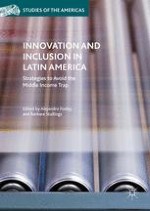2016 | OriginalPaper | Chapter
8. Middle Classes and Education in Latin America
Authors : Osvaldo Larrañaga, María Eugenia Rodríguez
Published in: Innovation and Inclusion in Latin America
Publisher: Palgrave Macmillan US
Activate our intelligent search to find suitable subject content or patents.
Select sections of text to find matching patents with Artificial Intelligence. powered by
Select sections of text to find additional relevant content using AI-assisted search. powered by
